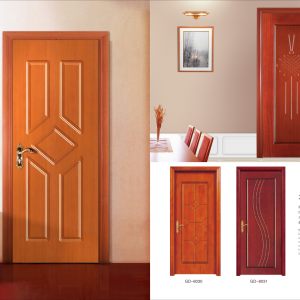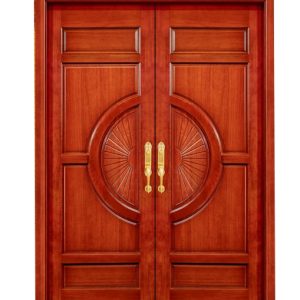**Wood Grain Transfer Process for Door and Window Profiles**
Wood grain transfer technology is applied to profiles that have undergone powder coating or electrophoretic coating. Based on the principle of high-temperature sublimation and thermal penetration, wood grain patterns on transfer paper or film are transferred onto the pre-coated or electrophoretically coated profiles through heating and pressure. This process results in clear, textured wood grain patterns that provide a strong visual and tactile sense of natural wood, making it an ideal eco-friendly alternative to traditional wood.
The wood grain finish adheres strongly to aluminum profiles, is non-toxic, odorless, and easy to clean. The patterns are vivid and realistic, providing a strong decorative effect that gives a “return to nature” visual appeal. The coating on the surface of the sprayed aluminum profiles does not volatilize, oxidize, or pollute the environment. Any surface contamination can be easily cleaned to restore its original appearance and shine.
Below is a detailed description of the wood grain transfer process:
### Process 1: Suitable for Large or Irregular Substrates
1. **Step 1**: Select the substrate that has already been powder-coated or electrophoretically coated.
2. **Step 2**: Wrap the substrate with wood grain heat transfer paper and secure the edges with heat-resistant tape to prevent the paper from loosening. (Note: The wood grain transfer paper’s patterned side must be placed against the substrate.)
3. **Step 3**: Encase the substrate in a heat-resistant, sealed plastic vacuum bag. Vacuum the air out from both ends until the plastic bag tightly adheres to the substrate. (The vacuum pressure should be adjusted based on the substrate’s characteristics and the bag’s tolerance.)
4. **Step 4**: Transfer the wrapped substrate into an oven. Adjust the temperature and baking time based on the substrate and desired depth of wood grain. The typical transfer temperature ranges from 160°C to 180°C, with a duration of 5 to 8 minutes.
5. **Step 5**: Remove the substrate from the oven, strip off the plastic bag, and peel away the transfer paper, then clean the surface.
### Process 2: Suitable for Flat Substrates
1. **Step 1**: Select a pre-coated or electrophoretically coated substrate.
2. **Step 2**: Place the wood grain transfer paper on top of the substrate, with the patterned side in contact.
3. **Step 3**: Use a flat heat transfer machine to apply pressure and heat. The typical transfer temperature is between 160°C to 180°C, with a time range of 18 to 25 seconds.
4. **Step 4**: Remove the transfer paper and use PET transfer film for finalizing the process.
### Process 3: Suitable for Irregular Substrates
1. **Step 1**: Select a substrate that has undergone powder coating or electrophoresis.
2. **Step 2**: Wrap the substrate in PET transfer film, and use an ultrasonic sealing machine to form the film into a tubular bag. (The patterned side of the PET film must contact the substrate.)
3. **Step 3**: Vacuum air from both ends of the PET film bag until it tightly adheres to the substrate. Adjust the vacuum pressure based on the substrate’s characteristics and the film’s tolerance.
4. **Step 4**: Transfer the wrapped substrate to an oven, with a typical transfer temperature of 160°C to 180°C and a baking time of 5 to 8 minutes.
5. **Step 5**: Remove the substrate from the oven and manually or mechanically blow air into the PET film to remove it from the substrate.
This wood grain transfer process ensures a durable and aesthetically pleasing finish, suitable for both large and small-scale door and window manufacturing.
Wooden transfer printing door
Wooden transfer printing door



